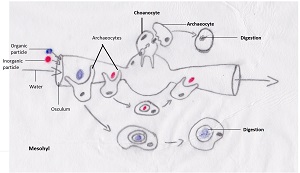Feeding
Sponges are suspension feeders. This means that organic particles from the water entering the sponge body are captured then ingested via phagocytosis (engulfing).
As the water passes from the incurrent canals to the excurrent canals (ostia-->osculum) generated by the beating flagella of the choanocytes, food particles are trapped by archaeocytes or chonacoytes depending on the size and location of the particles (Holmes et al. 2009; Kmerling and Carvalho de Souza, Ruppert et al. 2004). Smaller sized particles enter thechoanocyte chamber where the particles are trapped by small extensions (microvilli)on the choanocyte collar (Ruppert et al. 2004). Digestion occurs as particlesare phagocytosed in vesicles by archaeocyte or choanocytes (Ruppert et al.2004).
As some Cliona spp. house symbiotic zooxanthellae, this may provide the sponge with additional nutrient transfer, receiving most of its requirements from this relationship (Ruppert et al. 2004, Schonberg and Loh 2005). Nutrients may include excess photosynthates in the form of glycerol (Ruppert et al. 2004).This is beneficial to the sponge as it reduces the potential for nutrient limitation (Schonberg and Loh 2005).
 Diagram of sponge aquiferous system in feeding and digestion.
Diagram of sponge aquiferous system in feeding and digestion.
Image adapted from Ruppert et al. 2004.
|